On tour in Tasmania with Biota's James Viles
"Bloody hell, I love it down here," says chef James Viles as we stare into a frothing ocean and a photographer snaps a sign telling drivers to be mindful of penguins. "You would be so inspired to cook, waking up to this landscape every day."
Indeed. I love the grey-skied, silver-lined state, too. We're here because Viles is cooking for James Boags at the Melbourne Cup Carnival 2016, showcasing Tasmanian produce to match the Tasmanian beer. The owner/chef of Bowral's two-hatted Biota restaurant gives a big damn about the source of his ingredients, so instead of phoning a few farmers and having their goods shipped to Flemington, Viles insisted on driving around the Apple Isle himself and visiting the people behind the produce.
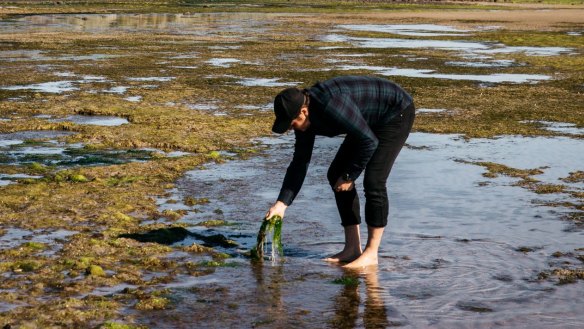
I accept an invitation to tag along for a few days because any opportunity to eat and drink around Tasmania is an excellent one. Here are the best things I had the joy of experiencing on the journey. Honorable mentions go to a rissole sandwich at Burnie truck stop and everything on the menu at Franklin.
Butter from Tasmanian Butter Co.
Tasmanian Butter Co. isn't an industrial garage with sad cows, it's a small shed attached to a suburban house in Launceston. Butter whisperer Olivia Morrison inoculates Tasmanian cream with lactic cultures and leaves it to ferment for 12-18 hours before churning.
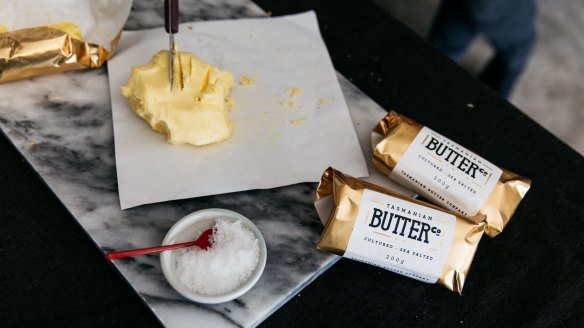
The result is a soft, light and nutty butter you can almost slice and eat like cheese. Tasmanian Butter Co. only started selling its dairy-based deliciousness in July and you can expect to see a lot more of it at markets and on dining room tables in the future.
Rib eye from Cape Grim Beef
Here's something: Cape Grim beef isn't all from Cape Grim. I've often wondered how a small patch of land (reported to have the cleanest air and rainfall in the world) produces enough beef to meet the demand of domestic and global markets and Neil Perry. The Rockpool chef can't get enough of the stuff.
Close to 800 Tasmanian farmers supply grass-fed beef to the brand and when driving around the state's north-west, it's common to see farm gates displaying the Cape Grim logo. After chatting to John Bruce, a Cape Grim supplier whose farm we cook at, it's clear there's a sense of pride in belonging to the group.
The beef is world-class gear that tastes of green pastures and cows that have lived a peaceful life. Our dinner at the Bruce farm was outdoors, on a long table overlooking Bass Strait. Viles brought a konro along for the trip (a traditional Japanese charcoal grill that brings out the best in anything it touches) and we spent a night eating barbecued southern squid and Cape Grim rib eyes as big as your head before retiring to our cabins happy and fat.
Fresh wasabi from Shima Wasabi
The sachets of hot green paste you get with lunchtime sushi - that's not really wasabi. It's more than likely horseradish, mustard and food colouring. The grated root of fresh wasabi has a taste that's long, hot and sweet. Far removed from the nose punch of a cut-price paste.
Top bloke Simon Welsh runs an impressive hydroponic set-up at Shima Wasabi near Devonport, with a climate-controlled greenhouse utilising rainwater captured onsite. Fresh wasabi is extremely delicate and if it's picked that day, it's shipped that day to any of the 60 odd Australian venues using Welsh's products, including many of Australia's top restaurants. (Quay's Peter Gilmore is a big fan of the mild, honey-mustard flavoured wasabi flowers.)
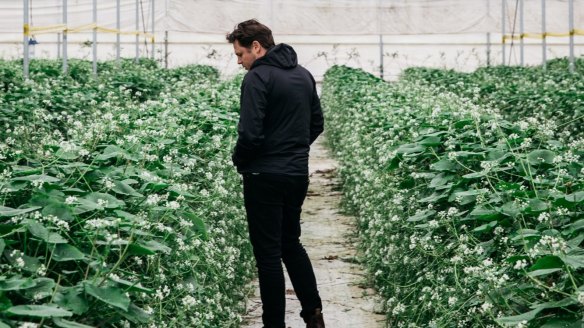
Welsh also experiments with growing other edible Japanese plants such as the turnips Martin Benn uses at Sepia that we're not allowed to touch and kinome - a citrus-y cousin of Sichuan peppercorn with minty and slightly tongue-numbing leaves. Welsh gifts Viles a punnet of kinome that makes its way into Robbins Island wagyu tartare for dinner that night. It's a properly brilliant dish.
XXX Ale from James Boag
WHY IS THIS NOT AVAILABLE ON THE MAINLAND? Boag's Premium Lager is all well and good. God knows I lived on the stuff for a fair chunk of my life. However, on a visit to the Boag's Brewery in Launceston (which is totally worth an hour or two of your time), I discovered this 100-year-old gem. It's crisp and refreshing, with the right amount of bitterness to make it super smashable on a hot day. Just make sure you ask for a Boags "red" not a Boags "triple x", otherwise you'll look like a right wombat. It took me a couple of days to work this out.
Oysters from Freycinet Marine Farm
Giles Fisher is the director of Freycinet Marine farm and he's the kind of chap I'd love to share a six-pack with on the end of a jetty. On a grey morning, we head five kilometres offshore to the marine zones where Fisher finishes his Pacific oysters. I should have worn something more waterproof than a denim jacket that day. Fisher hauls up oyster nets from the steely waters and Viles shucks bivalves on deck (I can't do it because I can't feel my hands). They taste buttery and primordial and it's about as good as an oyster-eating experience gets.
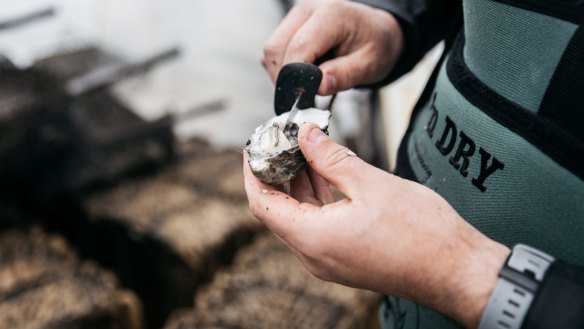
Oysters are available from Freycinet Marine Farm almost every day of the year and you don't have to brave angry waves to experience them. Fresh trays are available from the farm's sales room along with mussels, rock lobster and pan-fried abalone.
Pepper berry salt from Tasman Sea Salt
We were scheduled to visit the saltworks of husband-and-wife team Chris Manson and Alice Laing, but Viles found himself with a flat tyre en route. Then one kilometre down the road, my 4WD suffered a flat of its own. (Again, James, sorry for not pulling over when I passed you, mate. Legitimately thought you blokes were picking saltbush or something.)
Our spare tyres weren't designed for travelling at speed and the afternoon was spent tracking down replacement wheels. Shame, really, as the Tasman Sea Salt site at Little Swanport looks terribly attractive and it would have been awesome to check out the environmentally-friendly process that goes into harvesting the flakes. Big props to Alice Laing for meeting us at a Swansea fish and chippery while we tracked down new tyres, and supplying us with Tasmanian pepper berry-infused salt. It made some ordinary battered hake taste much better than it had any right to.
Wakame-wrapped sea urchin from the ocean floor
Seaweed biologist Craig Sanderson and seafood marketer James Ashmore have founded Kai Ho ('ocean's treasure'), a new business focused on the sustainable harvesting and processing of edible seaweeds like wakame, red lettuce and mekabu. When we jumped in Ashmore's tinnie to visit an underwater seaweed forest, it was the most excited I'd seen Viles all trip. "It's like another world down there," he said. "Absolutely unbelievable."
The wakame tastes unbelievable, too. Especially when eaten on the beach and wrapped around delicate sea urchin tongue from the cold, dark depths of Tasmanian waters. Tassie sea urchin is the best in the country and I won't be argued on this.
Raw honey from Wellington Apiary
Why can't all honey taste like this pure, raw, coarse-filtered bee goodness produced by Robin and Antonia O'Brien? The couple founded Wellington Apiary in 2009 with a few hives in the centre of Hobart and now they have healthy bees making honey all over Tasmania.
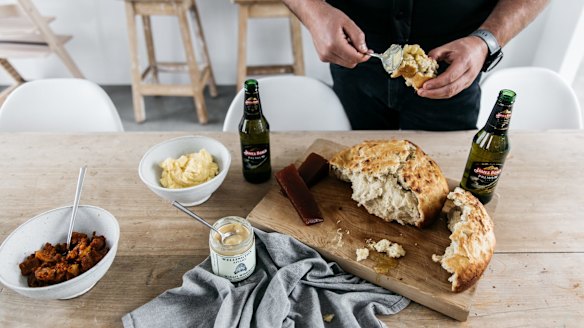
Viles mixed equal parts of the Apiary's Hobart Wildflower honey with Tasmania Butter Co. butter and a pinch of sea salt. Spread on fresh-baked damper, it was one cracker of a rainy morning breakfast.
Goat cheese from Leap Farm
The world needs more champions like Iain and Kate Field, who established a small farm in the Bream Creek district of southern Tassie in 2012. Iain was an ecology academic at Sydney's Macquarie University who decided it was time to practice what he researched and taught. The mixed-enterprise farm (there are dairy goats, meat goats and cattle) uses organic and biodynamic principles to make sure the landscape's ecology is improved during the Fields' time there. It's a place to make you smile thanks to incredible views and happy animals - the happiest of which are newborn milking goats.
The little bleaters will one day join their mums in donating milk as the Fields have plans to expand and make goat's cheese with minimal intervention onsite. Until then, the good people at Tongola Goat Products in nearby Wattle Grove are using Leap Farm's milk for fresh and washed-rind cheese that's creamy, balanced and beautiful.
"Iain and Kate are bloody legends," I say as we get back to the car, airport bound with boots caked in mud.
"Everyone we've met on this trip has been a legend," says Viles and I nod in complete agreement.
The author travelled as a guest of James Boag.
Restaurant reviews, news and the hottest openings served to your inbox.
Sign up